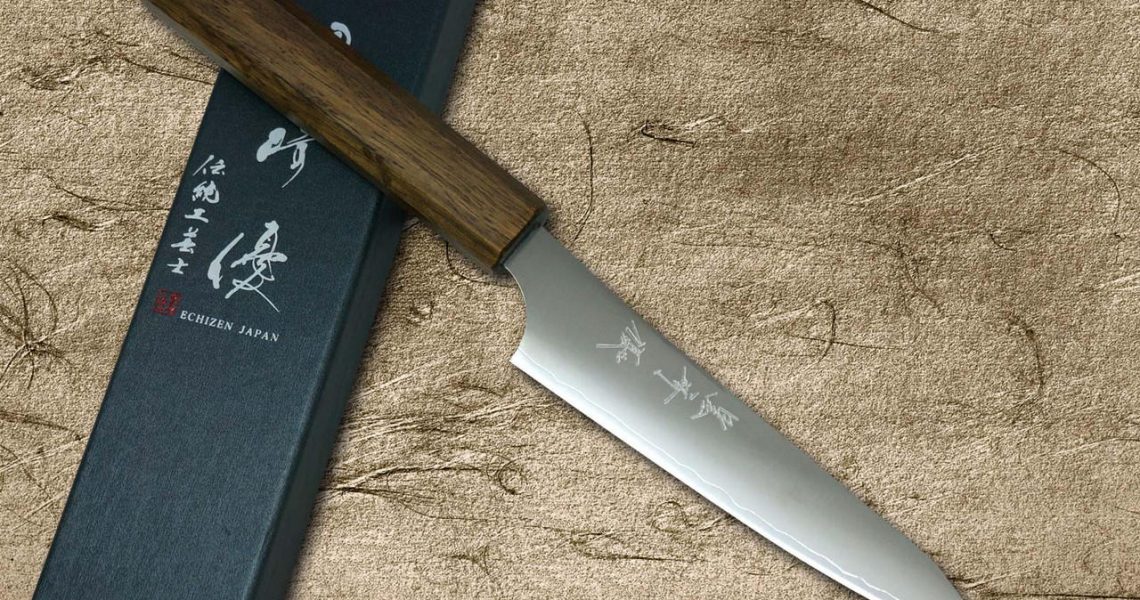Yu Kurosaki HAP40 GEKKO WA OK8M Japanese Chef’s Petty Knife (Utility) 130mm with Urushi Lacquered Oak Handle and Yu Kurosaki R2(SG2) Hammered SENKO-EI WA WN8W Japanese Chef’s Petty Knife (Utility) 130mm with White-Ring Walnut Handle
img by : https://www.hocho-knife.com/
Diners and gourmets who are big fans of Japanese food will definitely find it almost impossible to deny the cravings when a Japanese dish is served right in front of them, on elegant-looking plates. The vivid-colored pieces and slices of delicious Salmon or Mackerel placed and topped on cooked, warm Japanese rice mixed with several seasonings revealed the subtle flavors that are often described as delicate, yet exotic in many ways.
Due to the overwhelming popularity and fame coming from the almost-perfect satisfactory seen through online food reviews or by words of mouth, Japanese cuisine is never opted out of the list of the world’s most-loved cuisines.
Behind the extreme beauty of Japanese dishes, though, lies the challenge and complications in hand-crafting all these delicacies. Fans of Japanese food like sushi and sashimi regulars will definitely know what one has to go through to become a successful Japanese food chef – it isn’t as easy or simple as it seems. Despite sushi and sashimi’s simple aesthetics, these two delicacies are actually complex dishes to make.
Without a thorough and deep understanding of what these dishes really are and how they were meant to be cook, one can never make authentic and traditional sushi or sashimi. With this, Japanese food aspiring chefs are to learn and go through immense periods of training to fully grasp the concept of Japanese food prior to their chef debut. However, not only skills and training can lead to success in this field of specialized culinary arts. Among the most important components, kitchen equipment and the professionalism it carries play such a significant role in cooking.
Although there are various equipment and tools needed in the kitchen, a Japanese knife is indeed the most essential tool for a Japanese food chefs and culinary professionals. Japanese knives are products of high value among culinary experts and knife collectors from all parts of the world. The supreme quality of Japanese knives is just off the scales, exceeding the capabilities of what normal kitchen knives can do. Other than just cutting, chopping, slicing, boning, and filleting, a Japanese knife is capable of performing the intricate techniques required to successfully hand-craft Japanese delicacies like sushi and sashimi.
Known for the mesmerizing appearances, Japanese knives are loved even by knife collectors who look up to the amazing features and blade materials that are of premium quality. Narrow and long blade bodies make Japanese knives among the best cutleries for filleting, slicing, and boning of various fish and poultries. Its lightweight feature and blade hardness also contributes to the ease of grip and utilization, further making a Japanese knife high in demand.
Among the top-tier Japanese knife brands, Yu Kurosaki tops the charts for decades with its provision of professional knife models and series worth having in possession. Yu Kurosaki HAP40 GEKKO WA OK8M Japanese Chef’s Petty Knife (Utility) 130mm with Urushi Lacquered Oak Handle is among the top-selling models by Yu Kurosaki. The GEKKO series are all crafted out of the HAP40 Powdered High-Speed Steel made specifically by HITACHI Metals, which is one of the hardest blade-making steels in the world. This special steel provides the knife abrasion resistance, high edge retention, and durability. As HAP40 is a semi stainless steel, it will not be similar to chromium-rich general stainless steel.
For daily maintenance, it is recommended to clean and wipe the knife dry before storage. Yu Kurosaki R2(SG2) Hammered SENKO-EI WA WN8W Japanese Chef’s Petty Knife (Utility) 130mm with White-Ring Walnut Handle features a unique hammered texture that depicts firecrackers. Made out of the SG2 micro carbide powder stainless steel, it is also one of Yu Kurosaki’s ace models.
